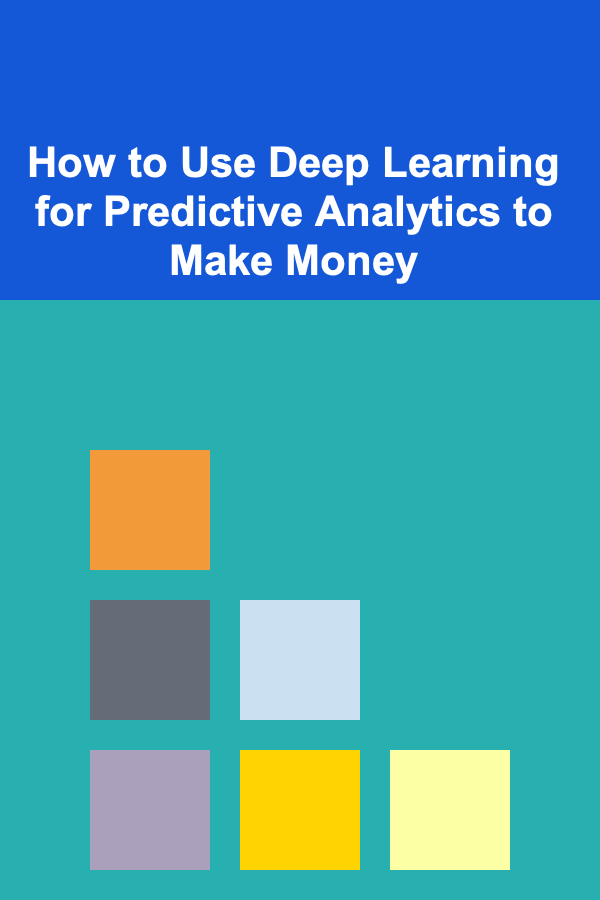
How to Use Deep Learning for Predictive Analytics to Make Money
ebook include PDF & Audio bundle (Micro Guide)
$12.99$5.99
Limited Time Offer! Order within the next:

Deep learning, a subset of machine learning, has become one of the most transformative technologies of the 21st century. It is a powerful tool that mimics the workings of the human brain to analyze complex datasets and make predictions with high accuracy. As businesses and industries increasingly rely on data to drive decisions, predictive analytics powered by deep learning has emerged as a game-changer.
Predictive analytics allows organizations to forecast future events, trends, and behaviors based on historical data. From predicting customer behavior to optimizing supply chains, the applications of predictive analytics are vast. In this article, we will explore how deep learning can be used for predictive analytics, with a particular focus on how it can be leveraged to generate revenue and create profitable opportunities.
What is Predictive Analytics?
Predictive analytics is the process of using data, statistical algorithms, and machine learning techniques to identify the likelihood of future outcomes based on historical data. Unlike traditional analytics, which focuses on understanding past trends, predictive analytics aims to forecast future events or behaviors.
The power of predictive analytics lies in its ability to provide actionable insights that can guide decision-making in various fields. Whether it's predicting stock prices, customer churn, or equipment failure, the goal is to use data to make smarter, more informed decisions.
Deep learning enhances predictive analytics by enabling the analysis of vast, complex datasets. With its ability to recognize patterns in high-dimensional data, deep learning can uncover insights that would be impossible for traditional methods to detect.
How Deep Learning Improves Predictive Analytics
Deep learning models, particularly neural networks, are capable of handling vast amounts of data and identifying intricate patterns. Here's how deep learning improves predictive analytics:
1. Handling Large, Complex Datasets
Traditional predictive analytics techniques, such as regression or decision trees, often struggle with large datasets that involve multiple variables or unstructured data (such as images, text, and video). Deep learning, on the other hand, excels at processing large and complex datasets.
For instance, convolutional neural networks (CNNs) are specifically designed to handle image data, while recurrent neural networks (RNNs) are used for sequential data such as time-series or natural language. Deep learning can effectively process these complex data types and derive predictions that traditional methods cannot.
2. Feature Engineering Automation
One of the most significant advantages of deep learning is its ability to perform automatic feature engineering. Traditional machine learning algorithms often require extensive manual effort to preprocess data and select relevant features. Deep learning, however, automatically extracts important features from raw data during the training process. This reduces the need for domain-specific knowledge and expert intervention.
3. Improved Accuracy and Precision
Deep learning models are known for their high accuracy, particularly in cases where there is a large volume of data. They are capable of learning non-linear relationships and interactions within the data, which can lead to better performance compared to traditional models. As a result, deep learning models are often the preferred choice when high predictive accuracy is critical, such as in financial forecasting, healthcare predictions, and marketing analysis.
4. Real-Time Predictions
Deep learning models can be trained to make real-time predictions, which is invaluable for applications where timely insights are crucial. For example, in fraud detection, deep learning models can analyze transactions in real time to identify suspicious activities. This capability opens up opportunities for businesses to act quickly and mitigate potential risks or capitalize on emerging trends.
How to Use Deep Learning for Predictive Analytics to Make Money
Now that we understand how deep learning enhances predictive analytics, let's explore how you can leverage this technology to create profitable opportunities. There are several ways in which deep learning-driven predictive analytics can generate income, whether through product development, consulting, or investing in data-driven business ventures.
1. Develop AI-Powered Products and Services
One of the most straightforward ways to make money with deep learning is by developing products and services that leverage predictive analytics. Businesses are always looking for tools that can help them make data-driven decisions and predict future outcomes.
a. Predictive Maintenance in Manufacturing
Predictive maintenance is a prime example of how deep learning can be used for predictive analytics in a profit-driven way. By analyzing data from sensors embedded in machinery, deep learning models can predict when equipment is likely to fail. This allows companies to perform maintenance only when needed, rather than relying on scheduled maintenance or waiting for breakdowns.
You can create a deep learning solution that helps businesses in the manufacturing sector predict equipment failures and sell it as a software-as-a-service (SaaS) platform. With a subscription-based model, companies can pay for ongoing access to your platform, which continually improves its predictive capabilities over time.
b. Customer Behavior Prediction
Another lucrative application of deep learning is predicting customer behavior. By analyzing historical purchase data, browsing behavior, and demographic information, deep learning models can predict when a customer is likely to make a purchase, what products they are likely to buy, or even when they might churn.
You can build an AI-driven platform that helps e-commerce businesses increase conversions by targeting customers with personalized product recommendations or special offers at the right time. This platform could be offered to businesses as a subscription service or a performance-based pricing model, where you earn a commission on sales generated through your predictions.
c. Stock Market Prediction
The financial sector is a high-stakes environment where predictive analytics has the potential to generate significant profits. Deep learning models can analyze historical stock prices, trading volumes, and other financial indicators to predict future market movements. These predictions can inform trading decisions, helping investors and hedge funds maximize their returns.
You can develop a deep learning-based stock market prediction tool and offer it to individual investors or financial institutions. This could be monetized through a subscription model or a pay-per-use basis, where customers pay for each prediction or market insight.
2. Offer Predictive Analytics Consulting Services
If you have expertise in deep learning and predictive analytics, you can offer consulting services to businesses looking to implement AI-driven predictive models. Many companies lack the in-house knowledge to develop these solutions themselves and are willing to pay for expert advice.
a. Customized Predictive Models
Businesses across various industries, including healthcare, finance, and retail, are increasingly adopting deep learning models for predictive analytics. However, implementing these models requires domain-specific expertise and customization. As a consultant, you can help companies build tailored deep learning models that suit their unique business needs.
For example, in healthcare, predictive models can be used to forecast patient admissions, optimize treatment plans, or predict disease outbreaks. In retail, predictive analytics can help businesses forecast demand, optimize inventory, or predict customer churn. As a consultant, you can charge clients based on the scope and complexity of the project.
b. Data Strategy and Implementation
Another way to monetize your deep learning expertise is by offering data strategy and implementation services. Many organizations need help in collecting, cleaning, and structuring their data to ensure that predictive analytics models perform optimally. You can help companies set up their data pipelines, integrate various data sources, and implement the necessary infrastructure to support deep learning models.
Consulting services can be offered on an hourly basis or as a project-based fee, depending on the complexity of the work. Over time, as you build a reputation in the industry, you can charge premium rates for your expertise.
3. Create and Sell Pre-Trained Models
Not all businesses have the resources to train deep learning models from scratch. As an expert in deep learning, you can create and sell pre-trained models that businesses can use to jump-start their predictive analytics efforts. These models can be sold on AI marketplaces or directly to companies in need of specific predictive solutions.
a. Pre-Trained Models for Specific Industries
You can create deep learning models tailored to specific industries. For example, a pre-trained model that predicts equipment failures in manufacturing or one that identifies fraudulent transactions in the banking sector can be sold to businesses within those industries. Once the model is trained and tested, it can be sold multiple times, generating ongoing revenue.
b. Licensing Models for Use
Another way to make money from pre-trained models is by licensing them to businesses on a recurring basis. For instance, you could license a predictive analytics model to a financial services company for use in their trading algorithm or offer a customer behavior prediction model to an e-commerce platform. Licensing agreements can be structured as one-time payments or subscription-based revenue streams.
4. Invest in Data-Driven Businesses
If you have a strong understanding of deep learning and predictive analytics, you can use your knowledge to identify data-driven businesses or startups with high potential for growth. By investing in these businesses, you can benefit from their success while leveraging your expertise to ensure they are making the right data-driven decisions.
a. Venture Capital in AI Startups
Investing in startups that use deep learning for predictive analytics can be highly profitable. Many AI startups are developing innovative solutions for industries such as healthcare, logistics, and finance. As a deep learning expert, you can evaluate their models and algorithms, helping them optimize their predictive analytics capabilities. In return, you can receive equity in these companies or be compensated for your consulting services.
b. Data-Driven Business Models
If you're interested in building your own business, you can create a data-driven company that relies on predictive analytics to provide value to customers. Whether it's a SaaS product, an AI-powered mobile app, or a data consulting service, the potential to generate revenue is vast in the field of predictive analytics.
5. Monetizing Predictive Analytics Through Education
Finally, if you're passionate about deep learning and predictive analytics, you can create educational content to teach others how to use these technologies. Online courses, webinars, and e-books are great ways to share your knowledge and generate passive income.
a. Create Online Courses
Deep learning and predictive analytics are in high demand, and many people are eager to learn about these fields. You can create online courses that teach others how to apply deep learning to predictive analytics problems. Platforms like Udemy, Coursera, and Teachable allow you to monetize your courses and reach a global audience.
b. Write Books or Articles
You can also write e-books or articles that explain how to use deep learning for predictive analytics. These resources can be sold on platforms like Amazon or self-published on your own website. Once published, you can earn royalties from book sales or ad revenue from articles.
Conclusion
Deep learning has revolutionized predictive analytics, offering businesses the ability to forecast future trends and make data-driven decisions with unprecedented accuracy. By leveraging deep learning for predictive analytics, there are numerous ways to make money, from developing AI-powered products and services to offering consulting, selling pre-trained models, and even investing in data-driven businesses.
As the demand for predictive analytics continues to grow, those who master deep learning have the opportunity to build lucrative income streams while contributing to the next wave of innovation in industries ranging from healthcare to finance, marketing, and beyond.
Reading More From Our Other Websites
- [Home Lighting 101] How to Use Dimmer Switches to Control Your Home's Lighting
- [Metal Stamping Tip 101] Comparing Online Metal Stamping Cost Calculators: Which One Is Right for You?
- [Organization Tip 101] How to Organize Personal Mementos by Theme
- [Organization Tip 101] How to Organize Household Chores for Seniors
- [Personal Financial Planning 101] How to Start a Side Hustle That Actually Generates Passive Income
- [Home Security 101] How to Use Two-Way Audio Security Cameras for Enhanced Home Surveillance
- [Home Maintenance 101] How to Diagnose and Treat Common Tree and Shrub Diseases in Your Backyard
- [Ziplining Tip 101] A Parent's Guide to Safe Ziplining Adventures with Kids
- [Biking 101] Top 5 Bike Saddles for Long-Distance Rides
- [Home Security 101] How to Protect Your Home from Carbon Monoxide and Smoke Hazards

How to Build Passive Income Streams with Deep Learning Projects
Read More
How to Create a Financial Plan After a Major Life Event
Read More
How to Update Your Home's Lighting Fixtures During Renovation
Read More
How to Generate Leads Organically: A Comprehensive Guide
Read More
How to Manage Client Expectations in Data Science Consulting
Read More10 Tips for Building a Payday Loan Repayment Plan with Tracking
Read MoreOther Products

How to Build Passive Income Streams with Deep Learning Projects
Read More
How to Create a Financial Plan After a Major Life Event
Read More
How to Update Your Home's Lighting Fixtures During Renovation
Read More
How to Generate Leads Organically: A Comprehensive Guide
Read More